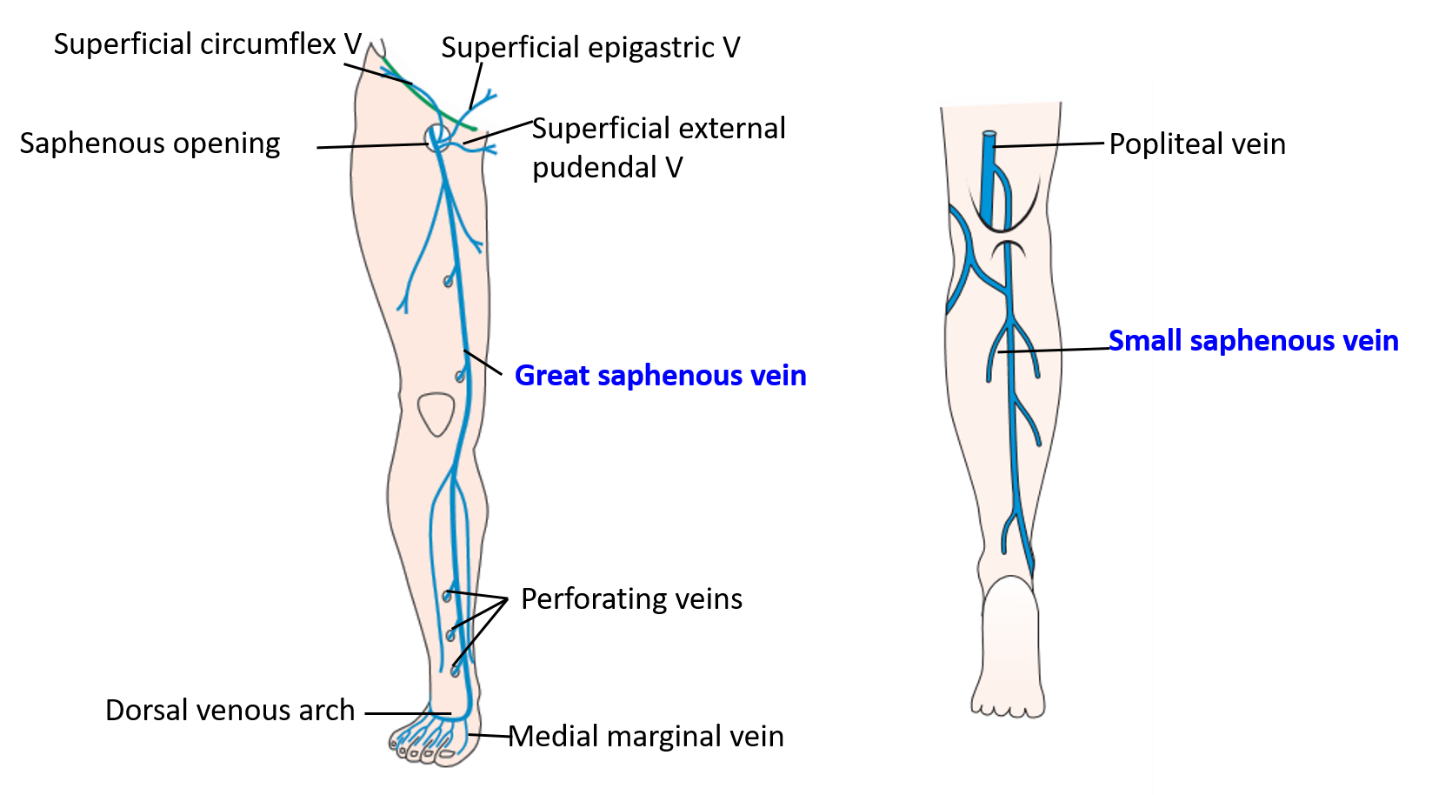Introduction
WATCH VIDEO OF VENOUS DRAINAGE OF LOWER LIMB [Click Here]
The veins of the lower extremity are subdivided into two sets- superficial and deep. The two set of veins are connected by perforating veins. Both sets of veins are provided with valves, which are more numerous in the deep than in the superficial set.

Describe the superficial veins of lower limb.
Superficial veins: the two important superficial veins are:
- Great saphenous vein
- Small saphenous vein
Great saphenous vein
- Is the longest vein of the body.
- It begins on the medial aspect of dorsum of foot by union of medial marginal vein & medial end of dorsal venous arch.
- It then ascends in front of medial malleolus, crosses the medial surface of lower third of tibia and ascend along the medial border of tibia to reach the posteromedial aspect of knee (about one hand-breadth posterior to patella).
- It further ascends along the medial side of thigh to reach the saphenous opening.
- It passes through the saphenous opening, pierces cribriform fascia and femoral sheath to drain into femoral vein.
- Tributaries:
- In leg:
- Posterior arch vein
- Anterior leg veins
- In thigh
- Anterolateral and posteromedial veins of thigh and
- Three vein join it before is pierces cribriform fascia:
- superficial epigastric vein
- superficial circumflex iliac vein
- superficial external pudendal vein
- In leg:
- Is accompanied by saphenous nerve in the leg and foot.
- Is connected to deep veins via perforating veins.
Small saphenous vein
- It begins at the lateral side of the dorsal venous arch.
- It then ascends behind the lateral malleolus and then along the posterior aspect of leg.
- It pierces popliteal fascia to open into the popliteal vein.
- It drains lateral side of the foot and leg.
- It is accompanied by sural nerve.
Describe the deep veins of lower limb.
Deep veins accompany the major arteries viz. anterior tibial, posterior tibial, popliteal and femoral veins.
What are perforating veins?
- Perforating veins are communicating veins between superficial & deep veins.
- They possess valves that prevent flow of blood from deep to superficial veins.
- They are present mainly in the region of ankle & medal side of lower part of leg.
Enumerate the factors that help in venous return.
- Contraction of muscles (especially calf muscle).
- Presence of valves prevents back-flow.
- Pulsations of arteries.
- Negative intrathoracic pressure.
Why soleus is known as peripheral heart?
In upright position, venous return from lower limb is largely dependent of contraction of calf muscles. Soleus contains rich plexus of valve less veins (venous sinuses) and the contraction of the muscle within the tight sleeve of fascia pushes the blood upwards from its large venous sinuses into the deep veins. During relaxed state of soles, the venous sinuses are filled from the superficial veins via perforating veins.
Applied Aspect
Great saphenous vein can be used for
- Venipuncture: for administration of intravenous fluid.
- Great saphenous vein graft in coronary bypass: Care should be taken to reverse the vein so that its valves do not obstruct blood flow in the graft.
Varicose veins of lower limb
- The veins (mainly superficial veins) of lower limb often become dilated and tortuous called varicose veins.
- The causes of varicosity are:
- Incompetency of valves of perforating or superficial veins.
- Persistent increase of intra-abdominal pressure (eg. abdominal tumours, pregnancy).
- Thrombosis of deep veins.
Trendelenburg’s Test
It is done to find the site of incompetent valve/s in superficial and perforating veins in a patient with varicose veins. The patient is asked to lie down and the veins are emptied by raising the lower limb and stroking the varicose veins in proximal direction. Pressure is then applied with thumb at saphenofemoral junction and the patient is asked to stand quickly.To test competency of valves of the superficial veins, the pressure at saphenofemoral junction is released. If the superficial varicose veins get filled immediately from above, the test is positive and indicates incompetency of superficial veins.To test incompetency of perforating veins, the pressure is not released for a minute. If the veins get filled from below, the test indicates incompetency of valves of perforating veins, as blood flows from deep to superficial veins.


Great
Good